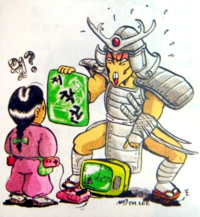Difference between revisions of "History of Sega in South Korea"
From Sega Retro
m (inline image (will look properly placed once article gets expanded with proper categories etc)) |
m (external links) |
||
| Line 28: | Line 28: | ||
*[[Wizard Soft]]<ref>https://web.archive.org/web/20010407222202/http://wzsoft.com:80/english/pd.html</ref> | *[[Wizard Soft]]<ref>https://web.archive.org/web/20010407222202/http://wzsoft.com:80/english/pd.html</ref> | ||
*[[Sonokong]] | *[[Sonokong]] | ||
| + | |||
| + | ==External links== | ||
| + | *''[http://www.hardcoregaming101.net/korea/gameindex.htm A History of Korean Gaming]'' article by Sam Derboo at [http://www.hardcoregaming101.net Hardcore Gaming 101] | ||
==References== | ==References== | ||
Revision as of 17:33, 19 September 2021
This short article is in need of work. You can help Sega Retro by adding to it.

|
| History of Sega in South Korea |
|---|
| Official Sega distributor(s): Oacs (198x-198x), Samsung (198x-1997), Kama Entertainment (1997-1998), Korea Data Systems (1997-1998), Hyundai-Sega Entertainment (1996-2000), SKC (199x-1998), Wizard Soft (1999-2005), Sonokong (200x-200x), Sega Korea (2003-present) |
In the 70s South Korea was one of the countries where Sega imported its game machines.
History
Oacs were responsible for the official distribution of the Sega Mark III.
Most of Sega's home consoles were distributed in South Korea by Samsung.The names were changed because the Japanese products were illegal in this region and thats why the Sega Master System was sold as Gam * Boy (later as Aladdin Boy), Sega Mega Drive as Super Gam * Boy (later as Super Aladdin Boy), Sega Mega CD as CD Aladdin Boy, Sega Game Gear as Handy Gam * Boy, Sega 32X as Super 32X and Sega Saturn as Samsung Saturn.
In 1994, Sega Digital Communications announced the launch of Sega Channel within a year, however, it is not known today whether this happened.
In February 1997, after poor Saturn sales Samsung exit from the gaming business. In September 1997, Sega Saturn returned this time under its original name. The distributor was Kama Entertainment and Korea Data Systems. Both companies also brought Sega Mega Drive under the original name.Wooyoung System translated games into Korean. Some of the games released by Samsung have been released for the second time.
In 1996 Sega formed a partnership with Hyundai, creating Hyundai-Sega Entertainment to bring arcade games and components to the country. The move was expected to produce $25 million USD in revenue for the two companies[1].
Soon, Hyundai decided to release Sega games on PC. In 1998, the company announced that it will become the distributor of the new Sega Dreamcast console. In late 1999, it was promised that the console would be available in early 2000 but the system was still not released. In May 2000, it was decided that the consoles will be imported in unchanged Japanese version.25,000 units were sent to Korea before Hyundai broke cooperation with Sega in September 2000. It is unknown if someone later sold Dreamcast in Korea.[2]
Since 2003, Sega Korea is a representative of Sega in South Korea.
Companies that distributed some Sega computer games:
External links
- A History of Korean Gaming article by Sam Derboo at Hardcore Gaming 101
